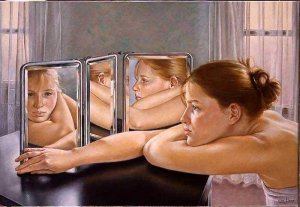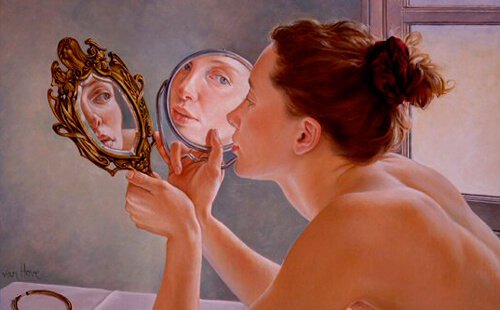The Law of the Mirror: Using Others to Solve Our Problems

The Law of the Mirror proposes that the origin of our negative feelings towards another person is within our “heart” and not in the other person. That is to say, what this law teaches us is that feelings are born from within ourselves. We are the ones responsible for managing our beliefs, ideas and bad thoughts about others.
Anger is usually born towards oneself and not towards the other person. That is to say, everything starts and everything ends in same person. It’s the projection that messes with our minds. It is as if our reality were a mirror that simply reflected the image we are generating.
Yoshinori Noguchi recreates this law in his book of the same name. He makes it into a beautiful story, one that could move you to tears. And also one which provides us with the possibility of accepting and integrating this idea into our everyday lives.
This author situates us in front of a mirror in order for us to confront our inner world. This is definitively the one which determines everything that happens in our lives. As Jung would say, “What you deny submits you and what you accept transforms you”.

What bothers us about others is what we are denying in ourselves
We should consider what bothers us about others. Why are we so bothered by our brother’s comments during family dinners? Think about it, why aren’t we capable of reasoning when we are with our sister-in-law? Why can’t we handle it when others don’t support us when we want them to?
It’s helpful to make a list of all of the things that bother us about the people around us. We are likely to notice that there are values that we are also underestimating. In other words, we will probably notice that there are things that we also do badly or wrong.
Why don’t we react the same way in a similar situation with everybody else? Why does a simple “Hello” irritate us from some people and doesn’t provoke a reaction at all when others say it?

The next step is for you to make a list about the things you have to be grateful for to those people that always make you uncomfortable. It’s likely that they have done something for you or for someone you appreciate.
We will know that we have been liberated when the thing that made us so uncomfortable about the other person stops bothering us and the experience that generated suffering in us stops repeating itself.
There are no time limits for this project. That is to say, we have to take our time to examine how many of the characteristics that bother us about the other person are also within ourselves. When we are finished, we can make another list about the issues which we would like to ask forgiveness for.
It might be hard. Upon finishing, we might notice that we created a forced list of small insignificant details. However, this costly gesture will serve us to realize that sometimes our gaze was hostile. That other times we have talked to them harshly or that we have critiqued them behind their back about something we shouldn’t have.

The last and bravest step is to get in contact with that person through a phone call, a letter, or a face-to-face meeting. We would have to give thanks for the motives that we have written down in the first list. Next, we will proceed to ask them for forgiveness for the things that are written down on the second list.
This is such a difficult step that we probably view it as unfeasible. However, we should ask ourselves if we want to eliminate this pain from our lives. Or is it worth it to maintain our pride as a way of life?

Knowing the Law of the Mirror helps us be more cautious. It keeps us from feeding our rancor and bad feelings. We shouldn’t forget that we project what we are carrying inside. Hence, everything we see in others will probably say more about ourselves than it does about them.
The Law of the Mirror proposes that the origin of our negative feelings towards another person is within our “heart” and not in the other person. That is to say, what this law teaches us is that feelings are born from within ourselves. We are the ones responsible for managing our beliefs, ideas and bad thoughts about others.
Anger is usually born towards oneself and not towards the other person. That is to say, everything starts and everything ends in same person. It’s the projection that messes with our minds. It is as if our reality were a mirror that simply reflected the image we are generating.
Yoshinori Noguchi recreates this law in his book of the same name. He makes it into a beautiful story, one that could move you to tears. And also one which provides us with the possibility of accepting and integrating this idea into our everyday lives.
This author situates us in front of a mirror in order for us to confront our inner world. This is definitively the one which determines everything that happens in our lives. As Jung would say, “What you deny submits you and what you accept transforms you”.

What bothers us about others is what we are denying in ourselves
We should consider what bothers us about others. Why are we so bothered by our brother’s comments during family dinners? Think about it, why aren’t we capable of reasoning when we are with our sister-in-law? Why can’t we handle it when others don’t support us when we want them to?
It’s helpful to make a list of all of the things that bother us about the people around us. We are likely to notice that there are values that we are also underestimating. In other words, we will probably notice that there are things that we also do badly or wrong.
Why don’t we react the same way in a similar situation with everybody else? Why does a simple “Hello” irritate us from some people and doesn’t provoke a reaction at all when others say it?

The next step is for you to make a list about the things you have to be grateful for to those people that always make you uncomfortable. It’s likely that they have done something for you or for someone you appreciate.
We will know that we have been liberated when the thing that made us so uncomfortable about the other person stops bothering us and the experience that generated suffering in us stops repeating itself.
There are no time limits for this project. That is to say, we have to take our time to examine how many of the characteristics that bother us about the other person are also within ourselves. When we are finished, we can make another list about the issues which we would like to ask forgiveness for.
It might be hard. Upon finishing, we might notice that we created a forced list of small insignificant details. However, this costly gesture will serve us to realize that sometimes our gaze was hostile. That other times we have talked to them harshly or that we have critiqued them behind their back about something we shouldn’t have.

The last and bravest step is to get in contact with that person through a phone call, a letter, or a face-to-face meeting. We would have to give thanks for the motives that we have written down in the first list. Next, we will proceed to ask them for forgiveness for the things that are written down on the second list.
This is such a difficult step that we probably view it as unfeasible. However, we should ask ourselves if we want to eliminate this pain from our lives. Or is it worth it to maintain our pride as a way of life?

Knowing the Law of the Mirror helps us be more cautious. It keeps us from feeding our rancor and bad feelings. We shouldn’t forget that we project what we are carrying inside. Hence, everything we see in others will probably say more about ourselves than it does about them.
This text is provided for informational purposes only and does not replace consultation with a professional. If in doubt, consult your specialist.







